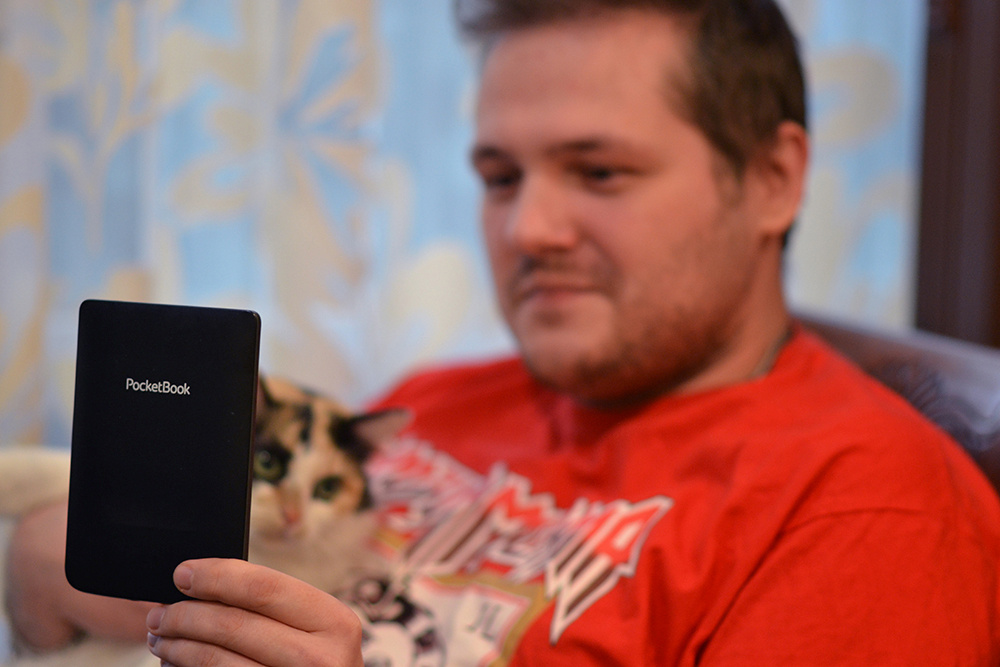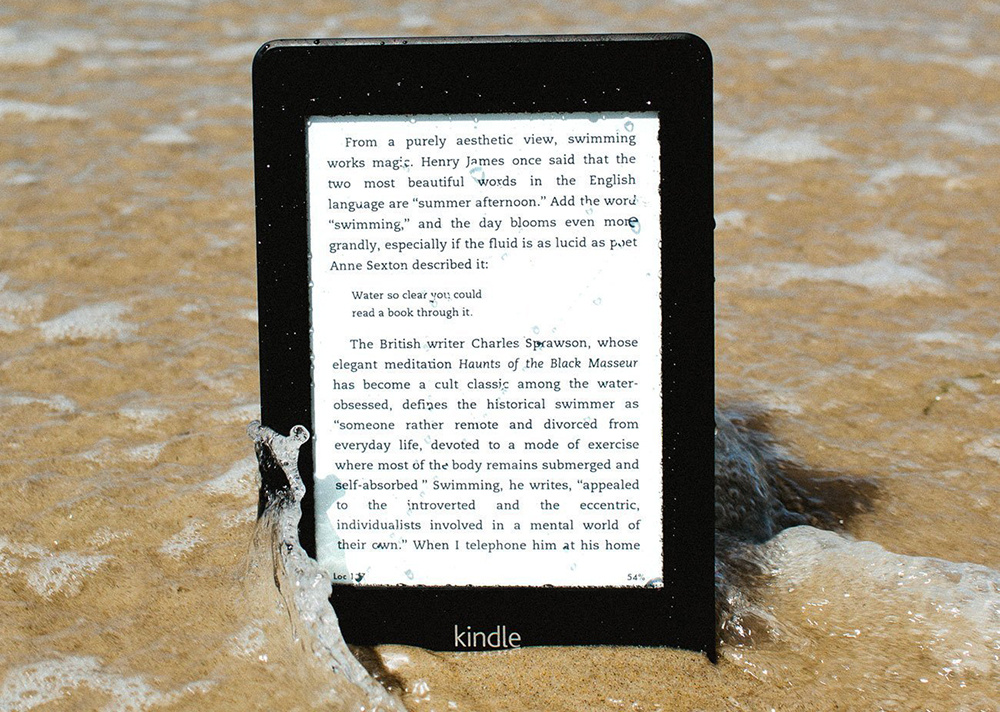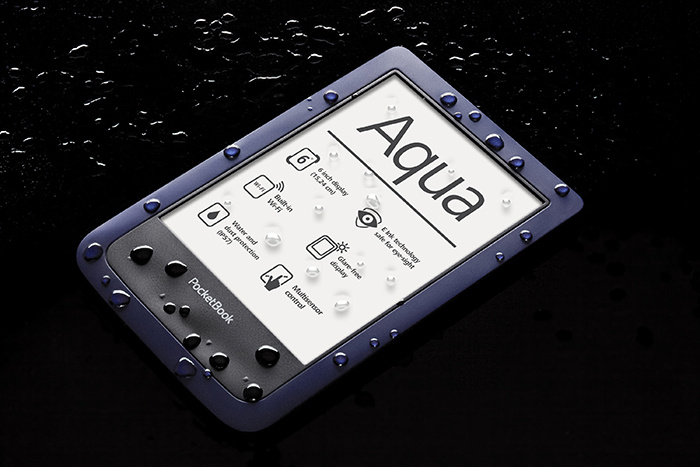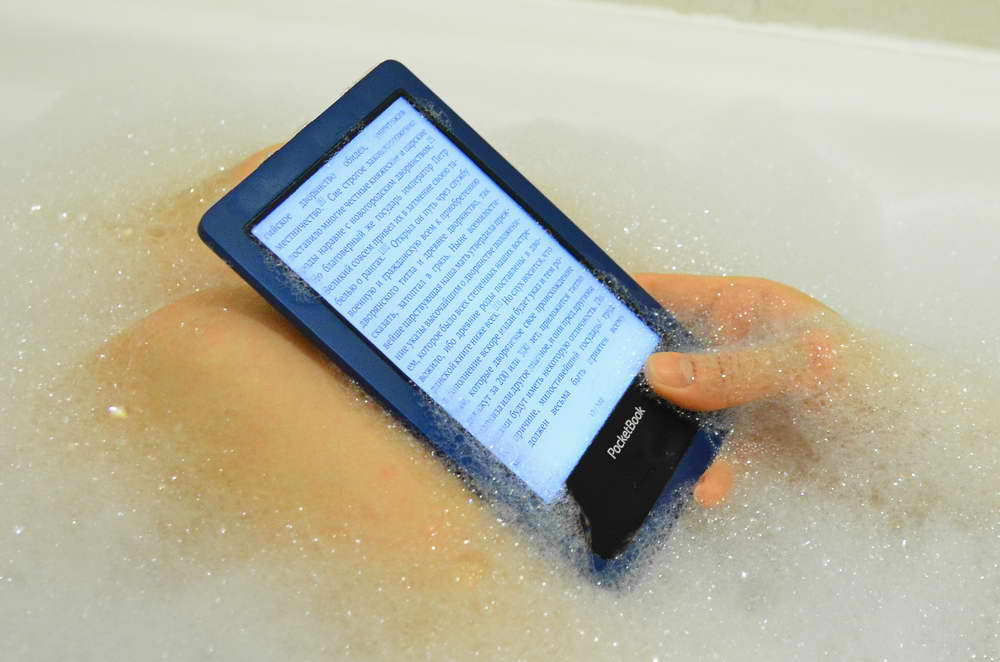How to make a reading room for a seaside holiday? Ways to protect readers from water: gel vs tulling
Hello! For a start, a small intro is off topic. Or, perhaps, just on the topic. In the comments to the previous posts in the official PocketBook blog, I have repeatedly heard accusations in my favor - they say, “Pockett” sold out, I am ready to close my eyes to his shoals, block the company by any means. Naturally, for the grandmother. Maybe you work in it - write in the comments. No, dear. I do not work in PocketBook. My name is Alexey Starodymov, I am a journalist and a columnist for iron. I have been testing gadgets for the past 10 years. I live in Odessa. Specifically, I have been using PocketBook readers since 2008. I had both Sonya and Kindly, and one more thing. But in the end, I still returned to the production of PocketBook. Just because I find it optimal for my tasks. And my cooperation with PocketBook comes down to the fact that in its official blog the company gives me a platform for “running” certain “carts” - and it does not climb into them and does not moderate what I give out. Nevertheless, it is beneficial for both parties: I have a platform and the opportunity to get acquainted with the latest PocketBook updates before others, and the PocketBook has a full blog.
Recently, I had the idea of a post about protected readers - and I asked the information I needed from PocketBook engineers for writing it. Engineers gladly shared. So our cooperation is beneficial not only for me and Pocket, but also, I hope, for the readers. Which I will discuss the protected below.

This is me with a cat and a reader
One or another technological piece can most often be implemented in several ways. For example, the background blur in pictures can be achieved with the help of two cameras, and with the help of one, but with special software algorithms. Well, or a long autonomy can be obtained through the use of a huge battery, and thanks to the "kit" of a relatively small battery and optimized system software. Protect this or that gadget from the water, too, in several ways. Formally, they all provide "indestructibility" of the device by dipping into the water, but ... There are nuances! We will consider them in this post. We will consider the example of electronic readers - after all, you read this post in the blog of the leader of the Russian reader market of the PocketBook company.
Certain distribution in the market of readers received protection against water using various kinds of gels. The process looks like this: the motherboard and other electronic components of the device are covered with a special compound, after which it ceases to be afraid of liquids.
For example, Amazon has already offered Kindle readers for a couple of years not from Amazon itself, but from WaterFi. She buys devices, disassembles them, processes her own production gel, assembles them back and gets protected copies. Which then tries to sell at a premium of $ 100 - this is just the price for the lack of hydrophobia. (To the extent that the wizards are in the WaterFi, evaluate yourself, considering that the waterproof PocketBook 641 Aqua 2 costs only 1,000 rubles more than the equivalent of the PocketBook 626 Plus, in which there is no protection.)

WaterFi demonstrates nice photos of readers processed with its gel, without specifying what will happen if the reader does not dry after such a bath
Everything would be fine, but the developers from PocketBook analyzed similar gels even in the process of creating the world's first protected reader - the PocketBook 640 Aqua 2014 sample. There are about a dozen of such compounds on the market, and the instructions to them say something like the following: after the treated device enters the water, it should be immediately removed and dried for 48 hours. If you do this, then the likelihood that the gadget will die, decreases, and it can be used further. So the use of a gel cannot be called a full-fledged protection - it is rather an easy insurance. The manufacturers of gels actually do not guarantee survival.

PocketBook 640 Aqua - the world's first protected reader. And it was not protected with the help of a gel, but by completely different means - about them below
The logic of manufacturers of devices treated with gel is as follows: people actually rarely water protected gadgets, protection is by and large a psychologically important point, it gives a feeling of confidence, and most of them are enough. And if for 500 (for example) copies sold, they will be drowned a couple of pieces, then we will replace them under warranty - business!
There are some other cases. For example, in Kobo Aura H2O a gel of the company HZO is used, and this does not prevent the Kobo guys from telling that their product can be immersed in water for two meters and pickled there for half an hour. Judging by the videos on YouTube, where the Aura H2O parsing process is shown, we can draw the following conclusion: the model has a minimally protected case (it understands too easily), but still somehow protected, which makes it possible to speak of IPX8 certification despite the use of the gel. Which, as mentioned above, is able to "give" the life of the device only if its (device) immediately after immersion in water to get and dry.

Kobo has his own way: minimally protected body + gel. The reliability of this method is fashionable only to guess.
The fact that the gels do not give normal protection, says this situation as well. In the fall of 2016, one reader with IP67 protection was announced in Russia - naturally, with the help of a gel (also from HZO). On sale, he appeared, however, only in June 2017. And information about the protection somewhere ... disappeared. Now the developers of the device say that it is not afraid of splashing water. Probably, during the testing process, it was on the immersion that the gel showed itself far from the best. The developers realized that the percentage of surviving after bathing devices is too low, and decided to limit the declaration of splash protection. What is not serious at all: almost all gadgets are protected from splashes, this is not even pleasant to write on the boxes.

Correspondence with the technical support of the brand, which the IP67 standard first promised in its reader, and then realized only splash protection
Well, for the sake of order, let's say how protection in PocketBook 641 Aqua 2 is organized. It is organized with the help of tuling - this is a whole set of measures designed to make the case airtight. That is, the protection is not provided by the gel with dubious properties, but, roughly speaking, by the most accurate and careful adjustment of the elements of the body, the presence of rubber pads at all the panel joints, and so on. So that there are no gaps between them in which water could seep. Everything else, the tolerances for the production of the PocketBook 641 Aqua 2 were reduced by half compared to the conventional, unprotected PocketBook readers.

PocketBook 641 Aqua 2 can be safely dropped into the bathroom, and then NOT dried
Which gadget maker uses the same HZO gel? Once it was used in the Tag Heuer smartphone, a couple of times - in wireless headphones, once more - in a Nike bracelet. That is, it is not a mass technology, not a standard for the market at all, but simply one of the protection options, and far from the best. Because if it really was the best, then the list of devices in which the HZO technologies would be applied would be much wider. And then the company would have bought any mastodons like Apple or Samsung. But no, this is not happening. Because Apple, Samsung, LG, Sony, and with them the PocketBook protect their devices in the only correct and 100% guaranteed way - with the help of a tuling.

Samsung, Apple, LG, PocketBook - for serious guys only tuling. Point!
That is why PocketBook 641 Aqua 2 can be bathed for half an hour at a depth of a meter, and after that the reader does not need to be dried "for 48 hours." And that is why PocketBook 641 Aqua 2 can be called the only 100% guaranteed protected reader not only in Russia, but also, perhaps, in the world. And then the Kobo experiments with the gel raise many questions, even though the company gives promises about compliance with the IPX8 standard.
PS Well, I will share plans for the future. I have a friend-colleague Alexander Shub - a great specialist in car recorders. Plus, he “fumbles” well in the internal structure of portable electronics - I admit, this is not strong: all these chips, types of soldering, and so on. But I understand something in the readers, and he understands only the registrars. Therefore, we decided to take a couple of them up to a screw a couple of readers of different brands and show the difference in the quality of the assembly and the internal structure. Would you be interested in such a post for the authorship of two reviewers at once? What do you think?
Recently, I had the idea of a post about protected readers - and I asked the information I needed from PocketBook engineers for writing it. Engineers gladly shared. So our cooperation is beneficial not only for me and Pocket, but also, I hope, for the readers. Which I will discuss the protected below.

This is me with a cat and a reader
One or another technological piece can most often be implemented in several ways. For example, the background blur in pictures can be achieved with the help of two cameras, and with the help of one, but with special software algorithms. Well, or a long autonomy can be obtained through the use of a huge battery, and thanks to the "kit" of a relatively small battery and optimized system software. Protect this or that gadget from the water, too, in several ways. Formally, they all provide "indestructibility" of the device by dipping into the water, but ... There are nuances! We will consider them in this post. We will consider the example of electronic readers - after all, you read this post in the blog of the leader of the Russian reader market of the PocketBook company.
Certain distribution in the market of readers received protection against water using various kinds of gels. The process looks like this: the motherboard and other electronic components of the device are covered with a special compound, after which it ceases to be afraid of liquids.
For example, Amazon has already offered Kindle readers for a couple of years not from Amazon itself, but from WaterFi. She buys devices, disassembles them, processes her own production gel, assembles them back and gets protected copies. Which then tries to sell at a premium of $ 100 - this is just the price for the lack of hydrophobia. (To the extent that the wizards are in the WaterFi, evaluate yourself, considering that the waterproof PocketBook 641 Aqua 2 costs only 1,000 rubles more than the equivalent of the PocketBook 626 Plus, in which there is no protection.)

WaterFi demonstrates nice photos of readers processed with its gel, without specifying what will happen if the reader does not dry after such a bath
Everything would be fine, but the developers from PocketBook analyzed similar gels even in the process of creating the world's first protected reader - the PocketBook 640 Aqua 2014 sample. There are about a dozen of such compounds on the market, and the instructions to them say something like the following: after the treated device enters the water, it should be immediately removed and dried for 48 hours. If you do this, then the likelihood that the gadget will die, decreases, and it can be used further. So the use of a gel cannot be called a full-fledged protection - it is rather an easy insurance. The manufacturers of gels actually do not guarantee survival.

PocketBook 640 Aqua - the world's first protected reader. And it was not protected with the help of a gel, but by completely different means - about them below
The logic of manufacturers of devices treated with gel is as follows: people actually rarely water protected gadgets, protection is by and large a psychologically important point, it gives a feeling of confidence, and most of them are enough. And if for 500 (for example) copies sold, they will be drowned a couple of pieces, then we will replace them under warranty - business!
There are some other cases. For example, in Kobo Aura H2O a gel of the company HZO is used, and this does not prevent the Kobo guys from telling that their product can be immersed in water for two meters and pickled there for half an hour. Judging by the videos on YouTube, where the Aura H2O parsing process is shown, we can draw the following conclusion: the model has a minimally protected case (it understands too easily), but still somehow protected, which makes it possible to speak of IPX8 certification despite the use of the gel. Which, as mentioned above, is able to "give" the life of the device only if its (device) immediately after immersion in water to get and dry.

Kobo has his own way: minimally protected body + gel. The reliability of this method is fashionable only to guess.
The fact that the gels do not give normal protection, says this situation as well. In the fall of 2016, one reader with IP67 protection was announced in Russia - naturally, with the help of a gel (also from HZO). On sale, he appeared, however, only in June 2017. And information about the protection somewhere ... disappeared. Now the developers of the device say that it is not afraid of splashing water. Probably, during the testing process, it was on the immersion that the gel showed itself far from the best. The developers realized that the percentage of surviving after bathing devices is too low, and decided to limit the declaration of splash protection. What is not serious at all: almost all gadgets are protected from splashes, this is not even pleasant to write on the boxes.

Correspondence with the technical support of the brand, which the IP67 standard first promised in its reader, and then realized only splash protection
Well, for the sake of order, let's say how protection in PocketBook 641 Aqua 2 is organized. It is organized with the help of tuling - this is a whole set of measures designed to make the case airtight. That is, the protection is not provided by the gel with dubious properties, but, roughly speaking, by the most accurate and careful adjustment of the elements of the body, the presence of rubber pads at all the panel joints, and so on. So that there are no gaps between them in which water could seep. Everything else, the tolerances for the production of the PocketBook 641 Aqua 2 were reduced by half compared to the conventional, unprotected PocketBook readers.
PocketBook 641 Aqua 2 can be safely dropped into the bathroom, and then NOT dried
Which gadget maker uses the same HZO gel? Once it was used in the Tag Heuer smartphone, a couple of times - in wireless headphones, once more - in a Nike bracelet. That is, it is not a mass technology, not a standard for the market at all, but simply one of the protection options, and far from the best. Because if it really was the best, then the list of devices in which the HZO technologies would be applied would be much wider. And then the company would have bought any mastodons like Apple or Samsung. But no, this is not happening. Because Apple, Samsung, LG, Sony, and with them the PocketBook protect their devices in the only correct and 100% guaranteed way - with the help of a tuling.

Samsung, Apple, LG, PocketBook - for serious guys only tuling. Point!
That is why PocketBook 641 Aqua 2 can be bathed for half an hour at a depth of a meter, and after that the reader does not need to be dried "for 48 hours." And that is why PocketBook 641 Aqua 2 can be called the only 100% guaranteed protected reader not only in Russia, but also, perhaps, in the world. And then the Kobo experiments with the gel raise many questions, even though the company gives promises about compliance with the IPX8 standard.
PS Well, I will share plans for the future. I have a friend-colleague Alexander Shub - a great specialist in car recorders. Plus, he “fumbles” well in the internal structure of portable electronics - I admit, this is not strong: all these chips, types of soldering, and so on. But I understand something in the readers, and he understands only the registrars. Therefore, we decided to take a couple of them up to a screw a couple of readers of different brands and show the difference in the quality of the assembly and the internal structure. Would you be interested in such a post for the authorship of two reviewers at once? What do you think?
All Articles